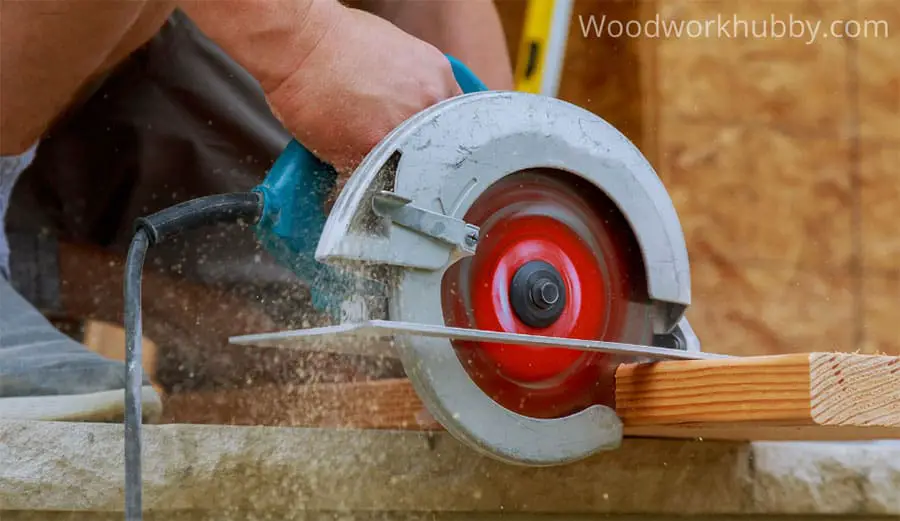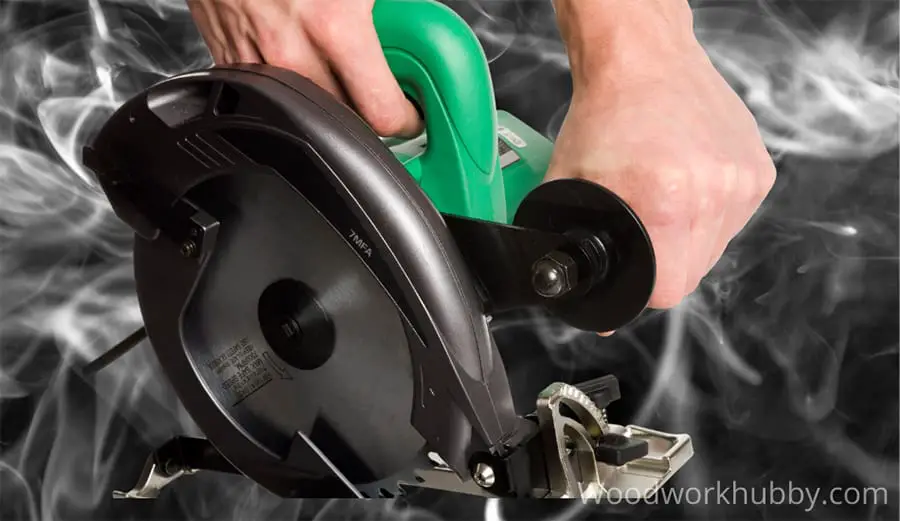I was cutting up some 2×4’s the other day with my circular saw and smoke started pouring out from my work area. Let’s just say I got a bit of a fright! But I’m sure most of us have been there and have also thought my circular saw is smoking. Why my circular saw smokes?
A circular saw will produce smoke from one of the following reasons:
- The blade is dull
- Cutting too much in one cut
- Incorrect blade
- Cut not straight
- Motor problems
When you are using the circular saw it is hard to know where the smoke is coming from. Let’s take a closer look below at each of these items so you can identify why is your circular saw smoking.
Where Is The Smoke Coming From?

The first thing to do is turn off your circular saw and unplug it. You don’t want any safety concerns. Next, you will need to take a close look at the wood you were cutting and the blade and see if there is any burning. I will explain why further on in this article.
If the wood is not burnt and the blade is clean, then it is possible the motor of your saw was smoking, but how do you tell? The smell of a burnt motor will be very clear to you. The smell is very overpowering and you will know straight away.
Keep reading for more info on motor burnout.
Why My Circular Saw Smokes – Reasons Why
There are so many reasons why your saw is smoking so let me explain each of the causes so that you can fix the problem and get back to cutting.
1. The Blade is Dull
A circular saw is one of the most commonly used saws in the workshop. After many cuts, the teeth on the blade can become dull and not cut as well. This can certainly be a major cause as to why your saw is smoking.
To check if your teeth are dull, you could unplug the saw and feel the edge of the teeth. This is hard for an inexperienced user to know.
A better way to check is to start making another cut. If you find the saw hard to push through the timber, your saw blade is certainly blunt and requires sharpening.
Make sure your blade is on the right way. See my article showing how.
Check The Set On Your Blades Teeth
This is a common cause of a saw smoking or burnt wood but not very many people know about it. Every saw blade has what is called “set” on the teeth. It is possible that a cheaper style saw blade may have the incorrect set on the teeth.
A blade’s set simply means that the teeth actually are alternatively pointing to the left and the right which makes the teeth cut 1-2mm wider than the thickness of the blade itself.
This set is very important as it stops the flat part of the blade from ever being in the contact with the timber. The teeth do all the work.
If your blade has little to no set, the flat part of the blade could be rubbing on the timber causing it to burn. Burning in turn will produce smoke.
Did you know sharp blades play a big role in how you cut MDF with a Jigsaw? I explain why in this article.
2. Are You Trying To Cut Too Much At Once?
If you are trying to cut a very thick piece of timber with possibly the wrong blade type, you can start burning the wood.
This will be caused by the cut timber fibers not escaping quickly enough and causing friction which leads to smoking.
If you do need to cut a thick piece of stock, I suggest reducing your depth of cut and try doing it in multiple passes. This will be easier for both you and the saw and you can prevent the blade from smoking.
3. Are You Using The Right Saw Blade?
Another very possible reason for burning or smoking is you may be using the wrong type of blade for the job.
Circular saw blades come with varying amounts of teeth on them and for good reason. Generally, the more teeth on the blade, the finer the cut especially when cross-cutting.
If you are cross-cutting thinner pieces of plywood you should opt for a lot of teeth on the blade which will give a neater cut.
If you are cross-cutting thicker pieces of timber, you might need a blade with slightly fewer teeth. If you are ripping a piece of timber that is very thick, you need to select a blade with fewer teeth again.
This is because the teeth of the blade need to get rid of all the cut timber fibers to allow the blade to move.
As you can see from above, the incorrect blade choice, especially in thicker timber, can cause your saw blade to produce smoke.
Keep Your Blades Clean
After using a saw blade for some time, the natural resins from inside timber can gum up your saw blade. You will notice this around the teeth of your blade.
If this build-up of gum gets too bad it can severely slow down your saw from cutting clean and can lead to excess friction and sometimes smoke coming from the blade.
Always clean your blade using this method
What Sort Of Wood Are You Cutting?
If your circular saw is smoking, there is a chance that the wood you are cutting could be causing this.
For example, If the timber is very hard and your blade is not super sharp, there is a chance the blade might smoke from a friction build-up. Some timbers are so hard that they can be very punishing on your tools.
Another cause is the timber you are cutting might be wet meaning it’s not fully dry. Wet timber can cause a gum build-up which in turn causes friction and smoke.
Possibly one of the most dangerous situations to get into when cutting with a handheld circular saw is when you come across timber that has a lot of tension built up inside of it.
You will only know this after you start cutting and you may feel the saw under strain to continue. What happens is the timber can bow in severely pinching the blade. This can be a cause of smoking also.
Smoking of the blade in this situation is possibly the minor of the two issues. When a blade gets pinched, the saw can kick backward towards you ever before you can react. This is one of the major causes of bodily injury from a circular saw.
Your saw blade could burn plywood. Can you burn plywood? Check out my full article on this.
Please exercise extreme caution and always stand to one side of the saw not directly behind it just like I explain in this post.
4. Are You Cutting Straight?
When using a circular saw, you should always be trying to cut it as straight as possible. This is because a saw blade can be up to 250mm in diameter and they don’t like curves too much!
Most people cut freehand with a circular saw meaning they cut with one hand while following a line. This is perfectly fine and normal but there is a tendency for the saw to wander.
If that happens, you may move the saw from side to side which will make the side of the saw blade bind against the timber. Excess binding of the blade may also cause smoke.
5. Is The Motor Smoking?

When you cut timber with your circular saw and smokes starts coming out, you will need to identify where that smoke is coming from.
If you have checked all of the above and none of these apply it could be smoke coming from the saw’s motor. Check by taking the saw away from the timber and starting the saw again.
If your motor has burnt out, the smoke will immediately start coming out of the side of the motor. The smell will be very strong and you will know straight away that the motor has burnt out.
Unfortunately for your hip pocket, it will be time to invest in a new saw.
Stick To Good Quality Saws
In my experience, I have found it always best to spend a little more on quality tools that will give you a quality finish and they will last longer.
Now I don’t want you to spend every last dime and buy the top of the line. Just consider spending a little extra to give you that quality.
Here are some of the saws I use and highly recommend which have lasted me for years.
Conclusion – Why Is My Circular Saw Smoking
As you will see from above there are many reasons why your circular saw is smoking during a cut. Mostly it will be because the blade is incorrect and is binding into the timber fibers of some form.
As we discovered though, in serious cases, it can actually be the saw motor itself that is smoking. I hope this article has helped you work out just why your saw is smoking!
Related Content
Why Is My Table Saw Smoking
The blade of your table saw will generally smoke because of one of the following reasons:
- The saw blade is dirty
- Incorrect feed rate
- Cutting too much at once
- Wrong blade for the type of timber or cut
All of these problems will be very similar to a circular saw. Please see the above article with an explanation of each of these.



